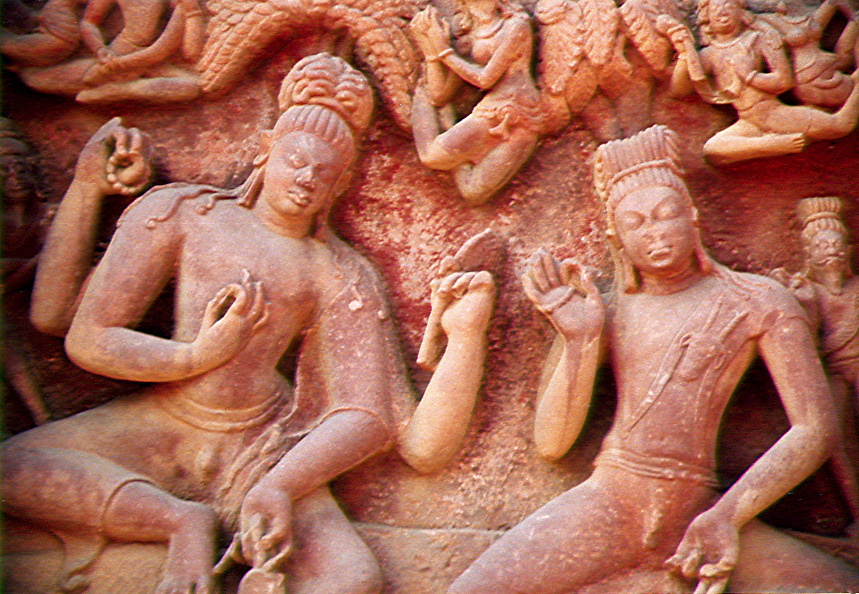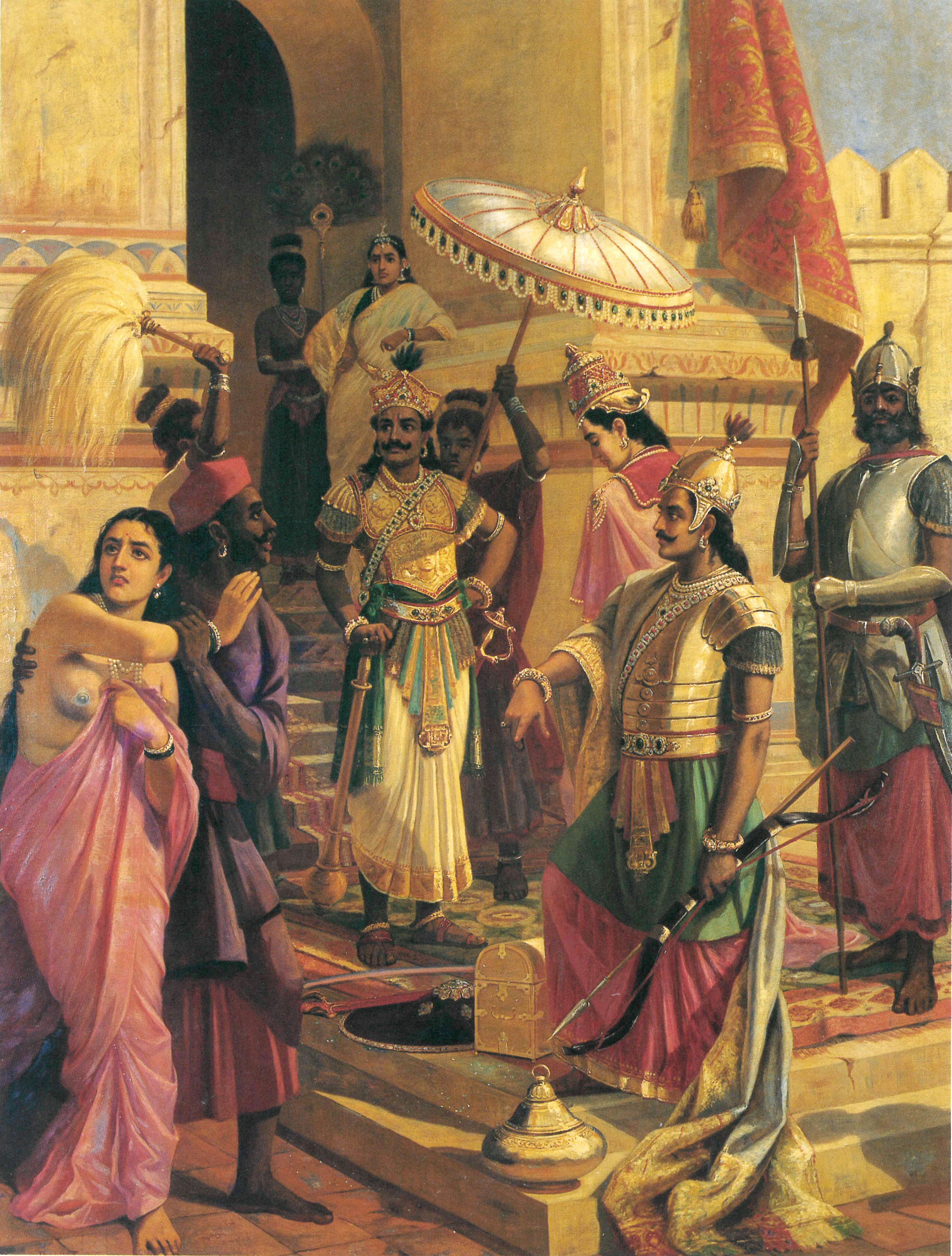|
Rigvedic Dialogue Hymns
The Rigveda contains a number of dialogue hymns ('s) in the form of dialogues, representing the earliest surviving sample of this genre. It can be argued to be an early precursor of Indian classical drama. They are found in the youngest part of the Rigveda ( RV 1 and RV 10), dating to roughly the 12th to 10th centuries BC, with the exception of the older River hymn ( RV 3.33), where the rivers answer in reply to Vishvamitra's prayer. *1.179 Agastya and Lopamudra (5 trishtubhs, 1 brhati) *3.33 Vishvamitra and the Rivers (12 trishtubhs, 1 anushtubh) *10.10: dialogue of Yama and Yami (12 anushtubhs) *10.51 Agni and the gods (9 trishtubhs) *10.86 Indrani, Indra, the "he-ape" Vrshakapi and his wife *10.95: dialogue of Pururavas and Urvashi (18 trishtubhs) *10.183: dialogue between the sacrificer and his wife (3 trishtubhs) See also * Gambler's Lament (a Rigvedic "monologue" hymn) References {{DEFAULTSORT:Rigvedic Dialogue Hymns Dialogue Dialogue (sometimes spelled dialog in ... [...More Info...] [...Related Items...] OR: [Wikipedia] [Google] [Baidu] |
Rigveda
The ''Rigveda'' or ''Rig Veda'' ( ', from ' "praise" and ' "knowledge") is an ancient Indian collection of Vedic Sanskrit hymns (''sūktas''). It is one of the four sacred canonical Hindu texts (''śruti'') known as the Vedas. Only one Shakha of the many survive today, namely the Śakalya Shakha. Much of the contents contained in the remaining Shakhas are now lost or are not available in the public forum. The ''Rigveda'' is the oldest known Vedic Sanskrit text. Its early layers are among the oldest extant texts in any Indo-European language. The sounds and texts of the ''Rigveda'' have been orally transmitted since the 2nd millennium BCE. Philological and linguistic evidence indicates that the bulk of the ''Rigveda'' Samhita was composed in the northwestern region of the Indian subcontinent (see) Rigvedic rivers), most likely between 1500 and 1000 BCE, although a wider approximation of 19001200 BCE has also been given. The text is layered, consisting of the ... [...More Info...] [...Related Items...] OR: [Wikipedia] [Google] [Baidu] |
Rigvedic Rivers
Rivers play a prominent part in the hymns of the ''Rigveda'', and consequently in early Vedic religion. Vedic texts have a wide geographical horizon, speaking of oceans, rivers, mountains and deserts. The Vedic land is described as a land of the seven rivers (''sapta sindhavaḥ''; sa, सप्तसिन्धवः) flowing into the ocean. It encompasses the northwestern Indian subcontinent from Gandhara to Kurukshetra. Geography of the Rigveda Identification of Rigvedic hydronyms has engaged multiple historians; it is the single most important way of establishing the geography and chronology of the early Vedic period. Rivers with certain identifications stretch from eastern Afghanistan to the western Gangetic plain, clustering in the Punjab. The region's name comes from پنج, ''panj'', 'five' and آب, ''āb'', 'water' thus " five waters", a Persianized form of the Indo-Aryan ''Panchanada'' meaning "five rivers". Many have cognates in Avestan. The same names were ... [...More Info...] [...Related Items...] OR: [Wikipedia] [Google] [Baidu] |
Urvashi
Urvashi ( sa, उर्वशी, Urvaśī}) is the most prominent apsara (celestial nymph) in Hindu mythology, considered to be the most beautiful of all the apsaras, and an expert dancer. She is mentioned in both ''Vedic'' and ''Puranic'' scriptures and is often portrayed as a ' swan maiden'. Urvashi is described to be born out of the thigh of sage Narayana and occupies a special place in the court of Indra, the king of the gods and ruler of svarga (heaven). She is famous for her marriage to Pururavas, a mortal king, whom she later abandons. Urvashi is also regarded as the mother of Vedic sages Vashishtha and Agastya. Etymology The Sanskrit name ''"Urvaśī"'' can have multiple meanings. It is derived from roots''uru'' and ''aś''. Some believe that the name has a non- Aryan origin. According to the scripture ''Devi Bhagavata Purana'', the apsara is known as Urvashi because she is born from the ''uru''—'thigh'—of the divine-sage Narayana. Indologist Monier Monier-Wi ... [...More Info...] [...Related Items...] OR: [Wikipedia] [Google] [Baidu] |
Pururavas
Pururavas (Sanskrit: पुरूरवस्, ''Purūravas'') is a character in Hindu literature, a king who served as the first of the Lunar dynasty. According to the Vedas, he is a legendary entity associated with Surya (the sun) and Usha (the dawn), and is believed to reside in the middle region of the cosmos. The Rig Veda (X.95.18) states that he was a son of Ilā and was a pious ruler. However, the ''Mahabharata'' states that Ila was both his mother and his father. According to the ''Vishnu Purana'', his father was Budha, and he was ancestor of the tribe of Pururavas, from whom descended the Yadavas, Kauravas, and Pandavas of Mahābhārata. Legends Birth and early life Pururavas was born in Treta Yuga, as the son of Budha and Ila. Budha was the son of Chandra, the moon god, and thus Pururavas was the first Chandravamsha King. Since he was born on Mount Puru, he was called Pururavas. Reign According to the Puranas, Pururavas reigned from Pratisthana (Prayaga). He perform ... [...More Info...] [...Related Items...] OR: [Wikipedia] [Google] [Baidu] |
Vrshakapi
Vrishakapi (Sanskrit: वृषाकपिः, IAST: ''Vṛṣākapi'') is a name found in vedic texts which in later texts is known as an alternative name of either Vishnu, Rudra or Surya Surya (; sa, सूर्य, ) is the sun as well as the solar deity in Hinduism. He is traditionally one of the major five deities in the Smarta tradition, all of whom are considered as equivalent deities in the Panchayatana puja and a m .... References External links Story of Vrishakapi Creator gods Destroyer gods Hindu eschatology Hindu gods {{Hinduism-stub ... [...More Info...] [...Related Items...] OR: [Wikipedia] [Google] [Baidu] |
Indra
Indra (; Sanskrit: इन्द्र) is the king of the devas (god-like deities) and Svarga (heaven) in Hindu mythology. He is associated with the sky, lightning, weather, thunder, storms, rains, river flows, and war. volumes/ref> Indra's myths and powers are similar to other Indo-European deities such as Jupiter, Perun, Perkūnas, Zalmoxis, Taranis, Zeus, and Thor, part of the greater Proto-Indo-European mythology. Indra is the most referred deity in the ''Rigveda''. He is celebrated for his powers, and as the one who killed the great evil (a malevolent type of asura) named Vritra, who obstructed human prosperity and happiness. Indra destroys Vritra and his "deceiving forces", and thereby brings rains and sunshine as the saviour of mankind. He is also an important deity worshipped by the Kalash people, indicating his prominence in ancient Hinduism. Indra's significance diminishes in the post-Vedic Indian literature, but he still plays an important role in various m ... [...More Info...] [...Related Items...] OR: [Wikipedia] [Google] [Baidu] |
Sachi
Indrani (Sanskrit: इन्द्राणी, IAST: ''Indrāṇī, lit.'' Indra's queen), also known as Shachi (Sanskrit: शची, IAST: ''Śacī''), is the queen of the devas in Hinduism. Described as tantalisingly beautiful, proud and kind, she is the daughter of the asura Puloman and the consort of the king of the devas, Indra. According to legend, due to her heavenly beauty and sensuality, Indrani was desired by many men, many of whom tried to marry her. When Indra was away performing his penance for the slaying of Vritasura, Nahusha, a mortal king of the Lunar dynasty, was chosen as the ruler of heaven. The latter tried to seduce Shachi and make her his queen, though she cleverly executed a scheme to dethrone him and later reunite with her husband. She is an important goddess in Shaktism, a major sect of Hinduism. Indrani (or Aindri) is one of the Sapta Matrika—the seven divine mothers. She is worshipped in South India as an independent deity, and is most often wo ... [...More Info...] [...Related Items...] OR: [Wikipedia] [Google] [Baidu] |
Agni
Agni (English: , sa, अग्नि, translit=Agni) is a Sanskrit word meaning fire and connotes the Vedic fire deity of Hinduism. He is also the guardian deity of the southeast direction and is typically found in southeast corners of Hindu temples. In the classical cosmology of the Indian religions, Agni as fire is one of the five inert impermanent elements ('' pañcabhūtá'') along with space (''ākāśa''), water (''ap''), air (''vāyu'') and earth (''pṛthvī''), the five combining to form the empirically perceived material existence (''Prakṛti''). In Vedic literature, Agni is a major and oft-invoked god along with Indra and Soma. Agni is considered the mouth of the gods and goddesses and the medium that conveys offerings to them in a ''homa'' (votive ritual). He is conceptualized in ancient Hindu texts to exist at three levels, on earth as fire, in the atmosphere as lightning, and in the sky as the sun. This triple presence accords him as the messenger between the ... [...More Info...] [...Related Items...] OR: [Wikipedia] [Google] [Baidu] |
Yama And Yami
Yama (Devanagari: यम) or Yamarāja (यमराज), is a deity of death, dharma, the south direction, and the underworld who predominantly features in Hindu and Buddhist religion, belonging to an early stratum of Rigvedic Hindu deities. In Sanskrit, his name can be interpreted to mean "twin". He is also an important deity worshipped by the Kalasha and formerly by the Nuristani peoples, indicating his prominence in ancient Hinduism. In Hinduism, Yama is the son of sun-god SuryaEffectuation of Shani Adoration pp. 10–15. and , the daughter of |
Vishvamitra
Vishvamitra ( sa, विश्वामित्र, ) is one of the most venerated rishis or sages of ancient India. According to Hindu tradition, he is stated to have written most of the Mandala 3 of the Rigveda, including the Gayatri Mantra. The Puranas mention that only 24 rishis since antiquity have understood the whole meaning of —and thus wielded the whole power of — the Gayatri Mantra. Vishvamitra is supposed to have been the first, and Yajnavalkya the last. Before renouncing his kingdom and royal status, Brahmarishi Vishvamitra was a king, and thus he retained the title of Rajarshi, or 'royal sage'. Textual background Historically, Viśvāmitra Gāthina was a Rigvedic rishi who was the chief author of Mandala 3 of the Rigveda. Viśvāmitra was taught by Jamadagni Bhārgava. He was the purohita of the Bharata tribal king Sudās, until he was replaced by Vasiṣṭha. He aided the Bharatas in crossing the Vipāś and Śutudrī rivers (modern Beas and Sutlej ... [...More Info...] [...Related Items...] OR: [Wikipedia] [Google] [Baidu] |
Dialogue
Dialogue (sometimes spelled dialog in American English) is a written or spoken conversational exchange between two or more people, and a literary and theatrical form that depicts such an exchange. As a philosophical or didactic device, it is chiefly associated in the West with the Socratic dialogue as developed by Plato, but antecedents are also found in other traditions including Indian literature. Etymology The term dialogue stems from the Greek διάλογος (''dialogos'', conversation); its roots are διά (''dia'': through) and λόγος (''logos'': speech, reason). The first extant author who uses the term is Plato, in whose works it is closely associated with the art of dialectic. Latin took over the word as ''dialogus''. As genre Antiquity and the Middle Ages Dialogue as a genre in the Middle East and Asia dates back to ancient works, such as Sumerian disputations preserved in copies from the late third millennium BC, Rigvedic dialogue hymns and the ''Mahab ... [...More Info...] [...Related Items...] OR: [Wikipedia] [Google] [Baidu] |
.png)


.jpg)

_Hindu_puja%2C_yajna%2C_yagna%2C_Havanam_in_progress.jpg)


.jpg)